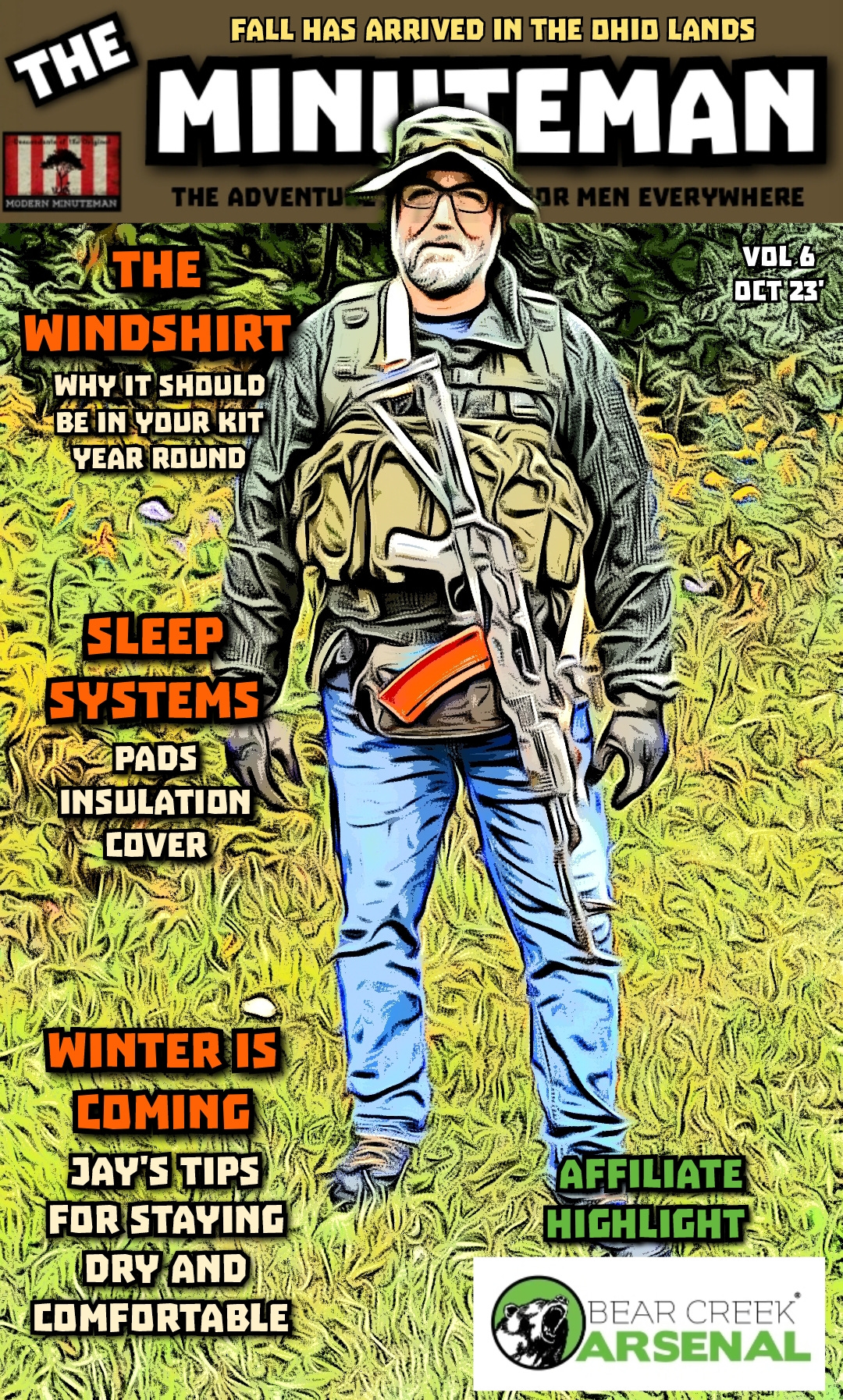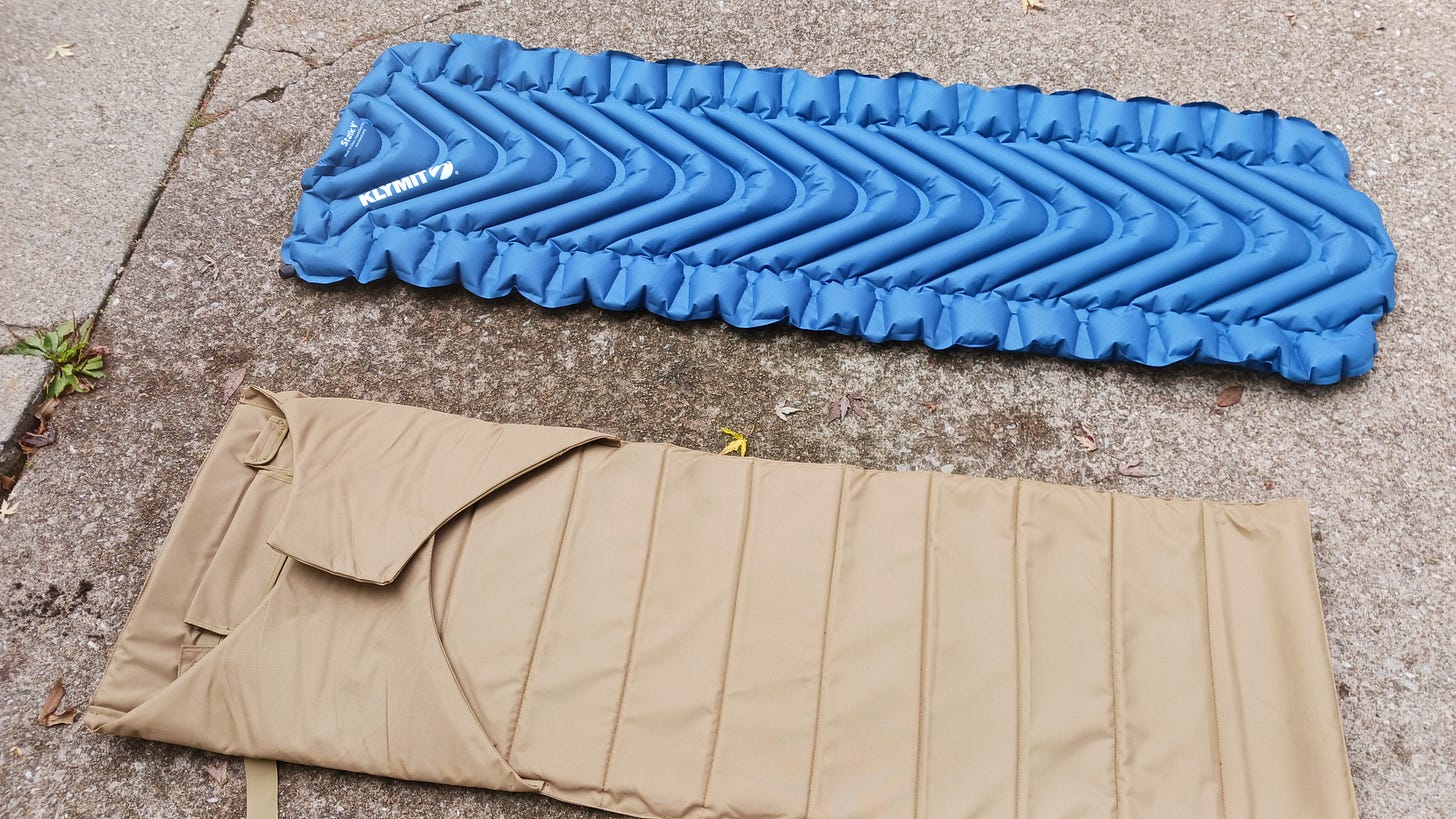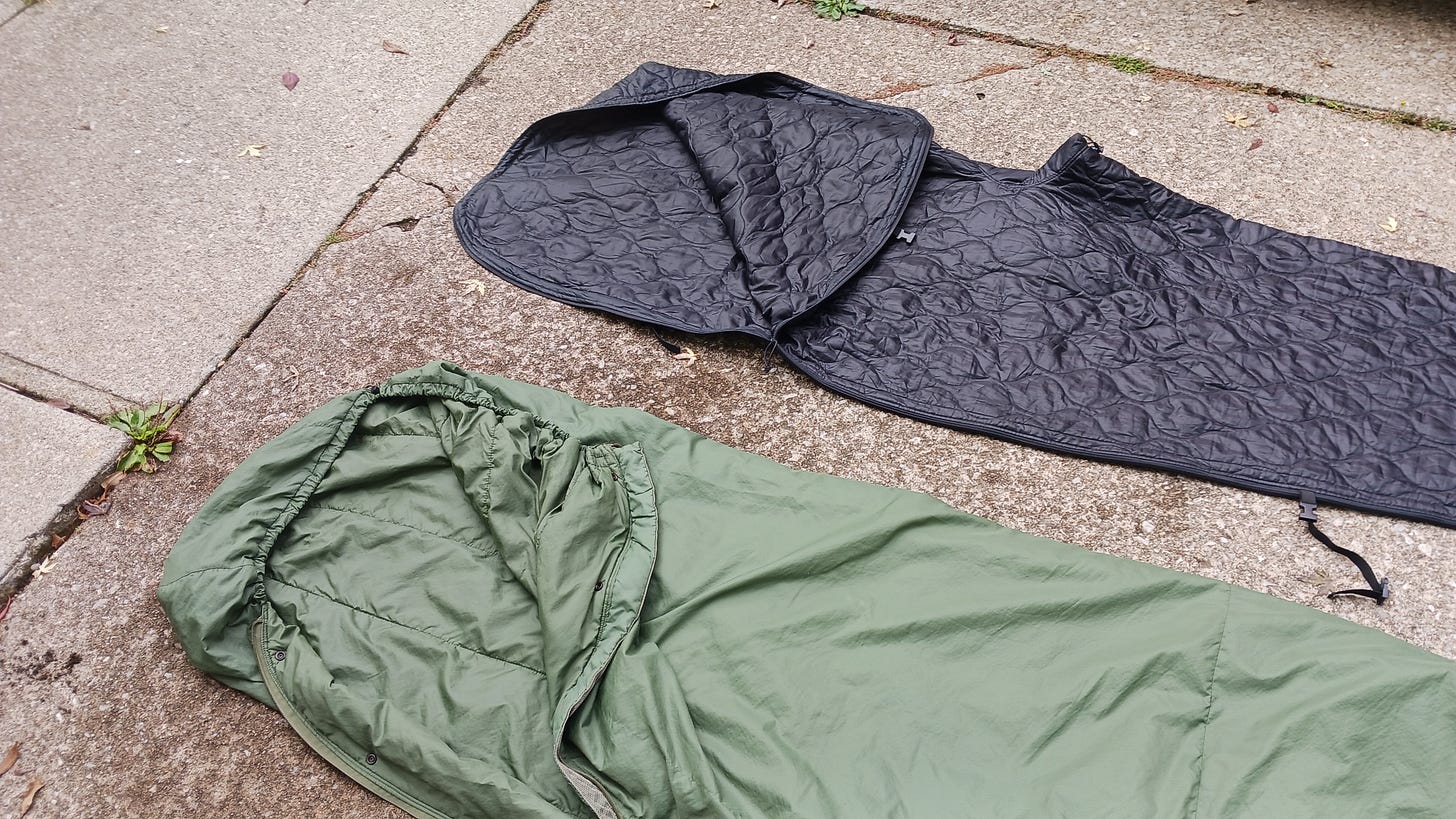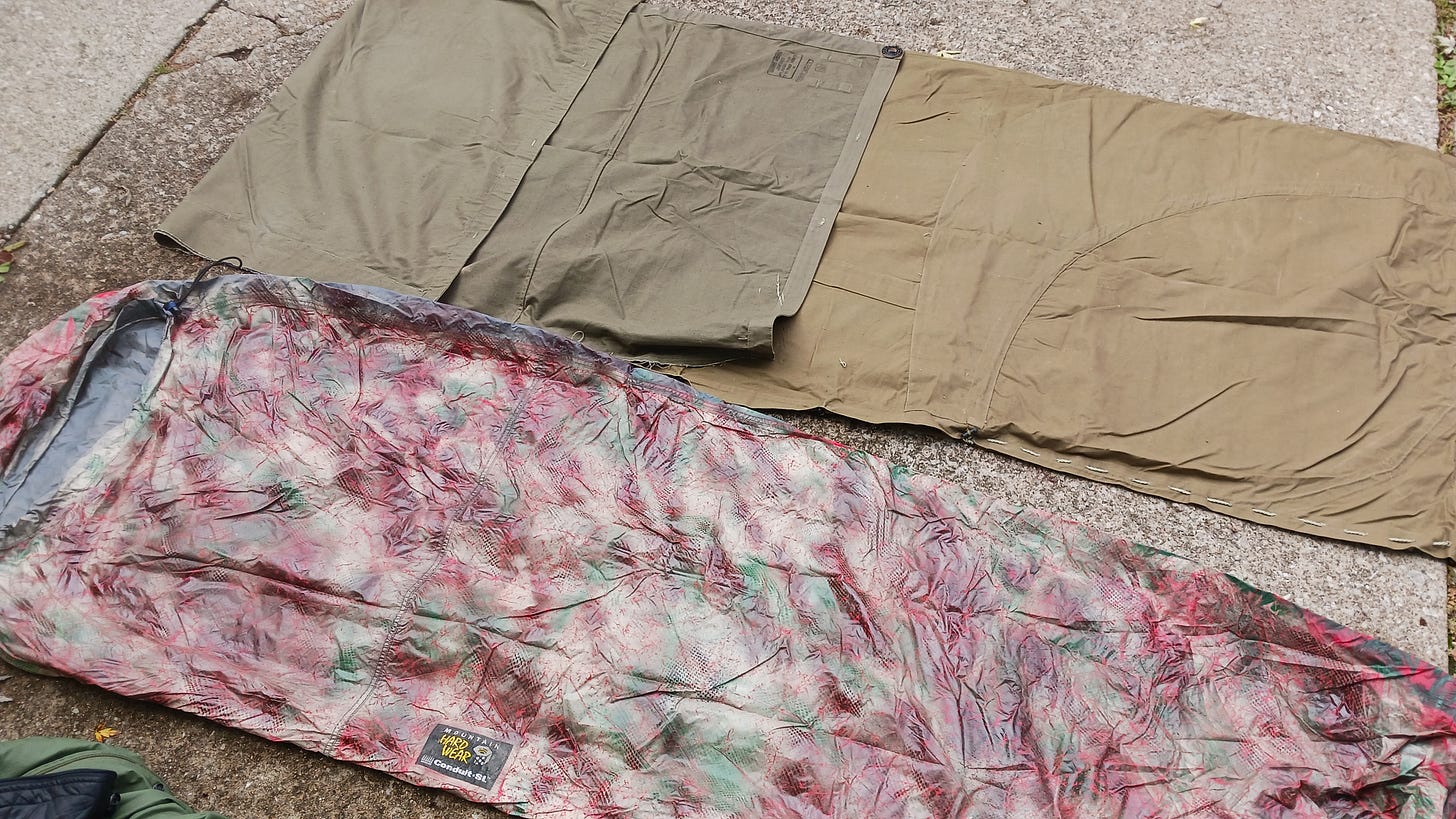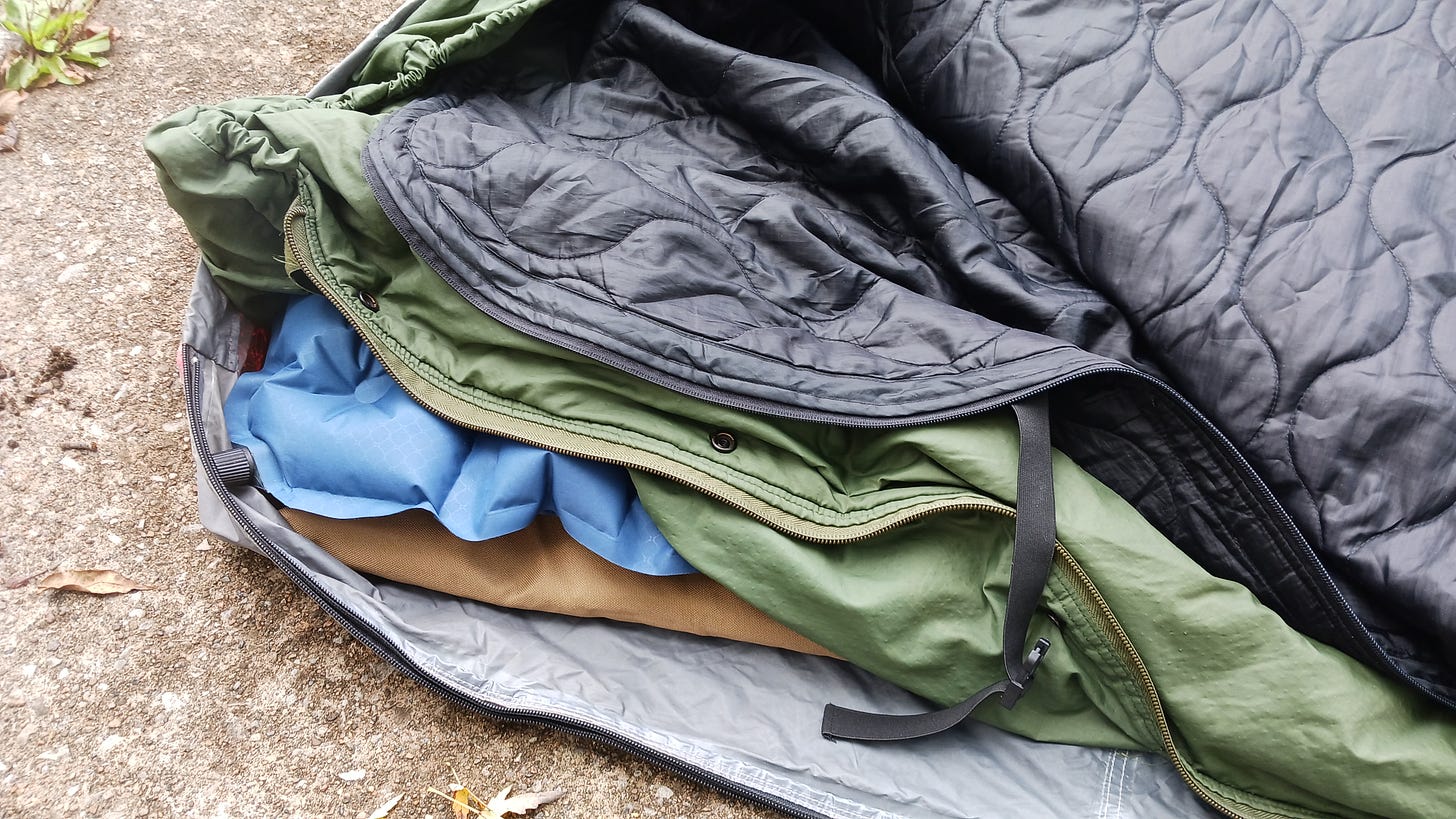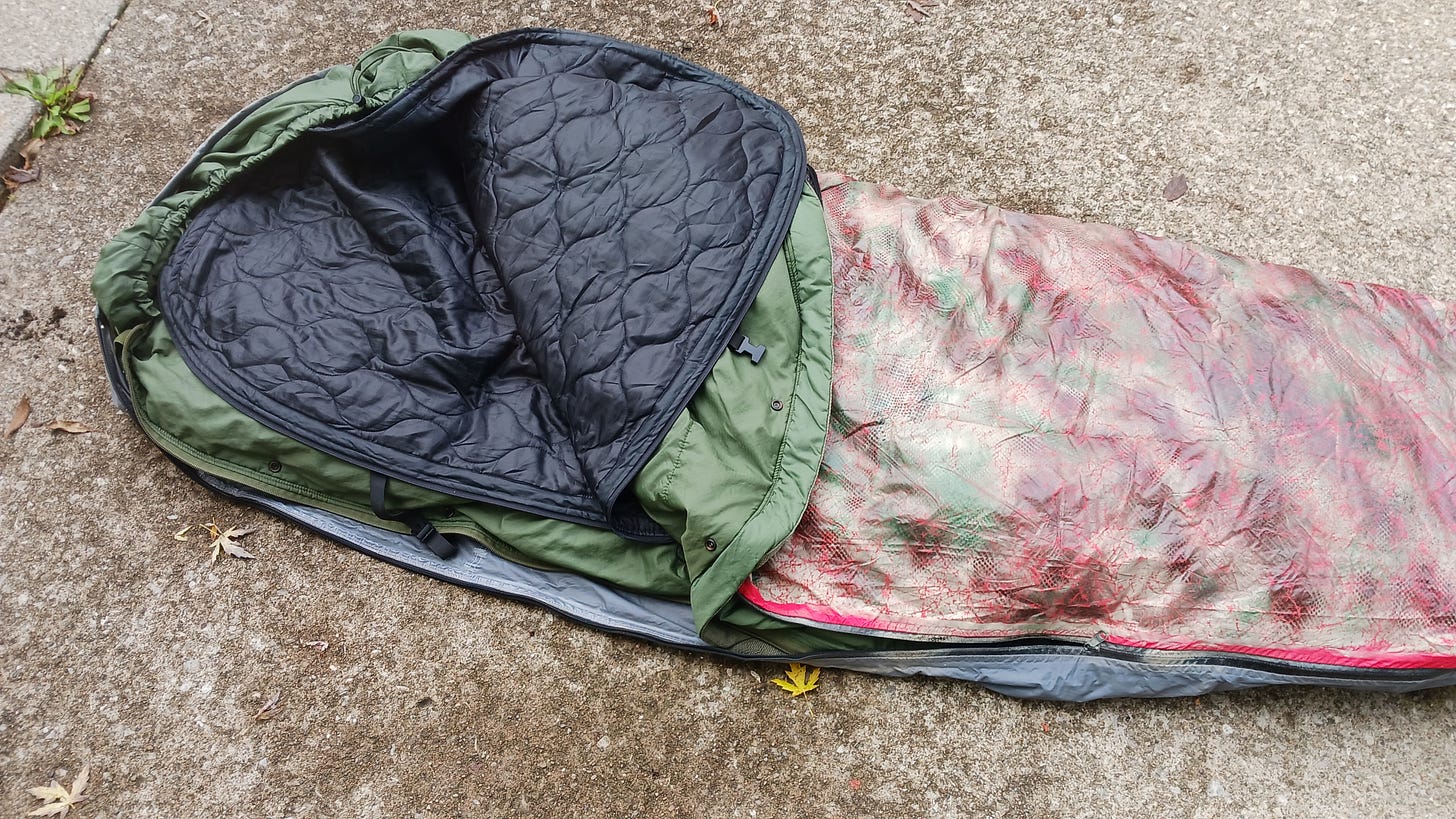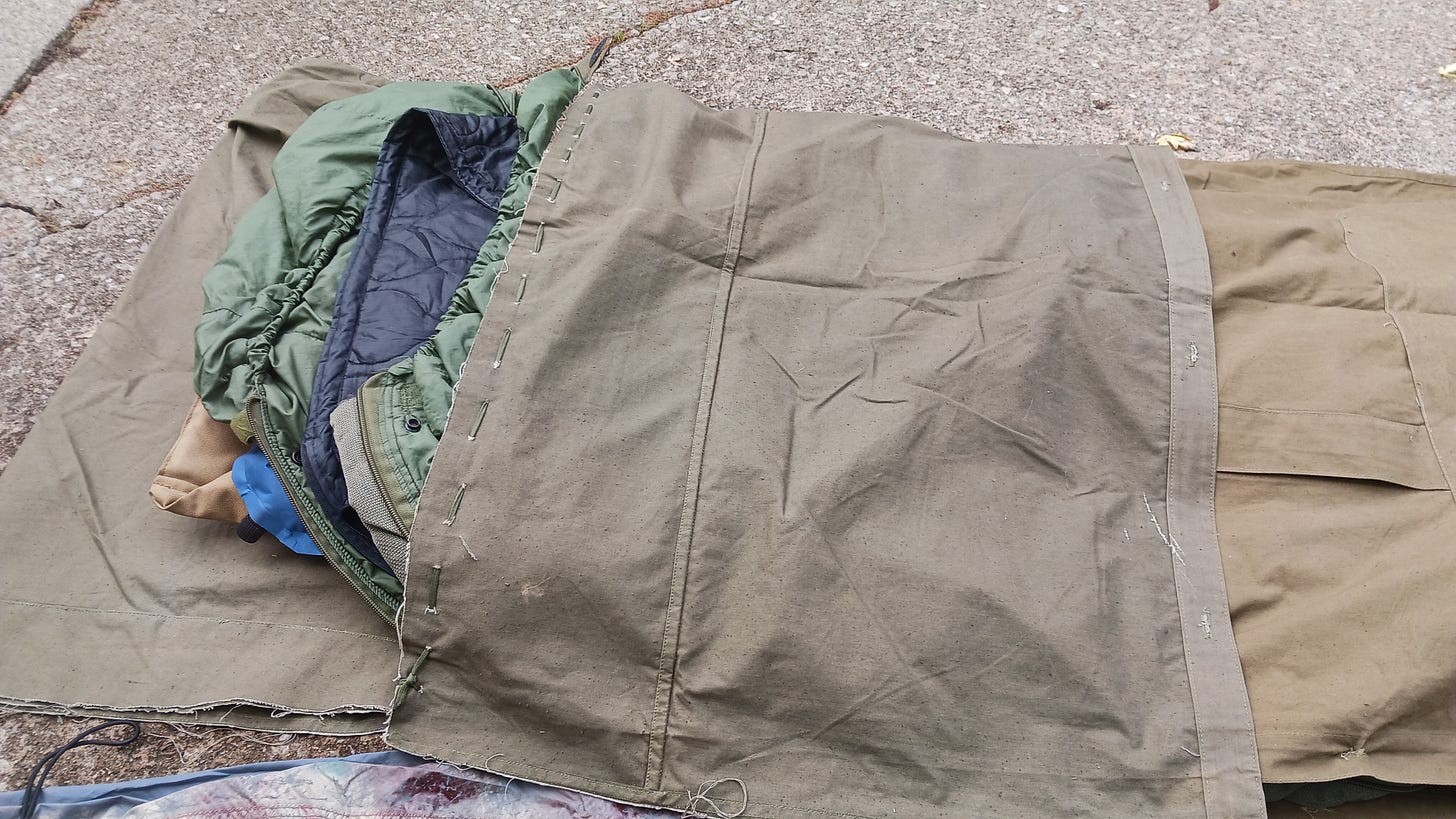THE MINUTEMAN Vol 6, October 2023
Windshirts, Sleep Systems, and Winter Tips
Fall is here and Winter is fast approaching, so now is a good time to start taking inventory and getting your cold weather kit in order. This issue we are going to go over a few key items to help you stay dry and comfortable during the upcoming months.
SLEEP SYSTEMS:
Sleep is important no matter the time of year, but becomes even more so in colder weather. Your sleep system really is made up of 3 main things: a sleeping pad, your bag, and your cover.
Sleeping pad: This is not only to provide cushioning but also to prevent heat conduction loss with the ground. The colder ground will suck the heat from your body, regardless of the rating of your bag, if you don’t have adequate insulation under you. You will see the term “R-Value” used when describing a sleeping pads thermal ability to resist cold traveling through it. The higher the R-Value then the warmer the pad will be, just as in home insulation. That lightweight inflatable pad used during the warmer months may not be enough for the winter temperatures. The colder the temps then the more you need under you.
My setup for the colder months it to double up on pads by using a closed cell foam pad like the old GI foam pads or ThermaRest Z-Fold pads with an inflatable on top. This gives me a couple extra inches of insulation under me without adding too much bulk to my overall sleep system.
Sleeping Bag: Your insulation comes from your bag(s). Down, synthetic, wool, etc are all popular choices with each having their own pros and cons.
Down- Pros: High warmth to weight/bulk ratio. Highly compressible, lightweight, breathable,long lasting when cared for, can be refilled. Cons: Expensive, tough to dry in the field if it gets wet (even from your own perspiration), will not retain warmth when wet, durability.
Synthetics- Pros: Cost effective, durable, maintains some warmth when wet, easier to dry (still sucks to do in the field), widely available. Cons: Can be bulky to maintain same warmth ratio as down counterpart, heavier (but has improved through the years), once the synthetic fibers start breaking down it needs to be replaced (durability), breathability.
Wool- I have wool added here for folks who enjoy using traditional cowboy/sleep rolls. Pros: Maintains warmth even when wet, breathable, durable, flame resistant, widely available, can be inexpensive with many military surplus options. Cons: Heavy, bulky, can be expensive, difficult to find good wool blankets.
Loft equals warmth in a sleeping bag. The more loft (thickness) there is then the more body heat it is able to efficiently trap, therefore keeping you warmer. Sleeping bags do not generate warmth, they trap your body heat as it radiates away from you. A mummy style bag that follows the shape of your body will also do a better job of this versus a large rectangular bag (less dead air space in the bag to heat up). This all plays a role in choosing the best bag for your needs.
Keep in mind that temperature ratings on a bag are a guideline, not an absolute. Some folks sleep colder/warmer than others. Bag ratings take into consideration a person of average build using a 1/4” foam pad and sleeping in a tent. But you need to consider your body type, metabolism, caloric intact/expenditure during the day, and more.
Cover: This is your weather protection layer or the outermost layer of your sleep system. For the type of field outing we usually discuss most of us aren’t utilizing tents except in special circumstances, so some sort of bivy sack is required to protect our sleep system from wind, rain, and snow. Once your bag gets wet you’re done and out of the game. There are a lot of options here with the most popular being the USGI Bivy Bag. Plenty roomy inside for winter weight bags and a pad. Yes, you read that right, your pad too. Most of us move around in our sleep and find ourselves off our sleep pads at some point in the night and get woken up by that cold spot that developed due to being off our pad. Putting your pad inside your bivy keeps your system all together throughout the course of the night keeping you warmer and more rested. So buy a bivy accordingly to fit your sleep system. Bivys are also great in the warmer months with just a Woobie (poncho liner) inside making an effective summer sleep setup. But beware, while bivys keep outside moisture out and are somewhat breathable, you can get condensation build up inside and this can wet your bag out on multi day outings, making it important to dry or air out your sleep system when safe to do so.
Some personal practices and recommendations based off my area of use…
I am in Ohio where the average summer temps are 81 as a high/61 as a low and winter being 35 as a high/24 as a low.
My summer sleep system consists of:
Pad-Padded Rifle Mat or Klymit Static V inflatable pad
Sleeping Bag-USGI Patrol Bag (green bag in MSS system) or Helikon-Tex Swagman Roll
Bivy Sack-Mountain Hardwear Conduit SL Bivy or canvas Plash Palatka utilized like a ranger roll.
My winter sleep system I use:
Pad-Combo of the above 2 pads
Sleeping Bag:-USGI Patrol Bag with Helikon-Tex Swagman Roll or Woobie inside (I have used this effectively down to 15-20 degrees)
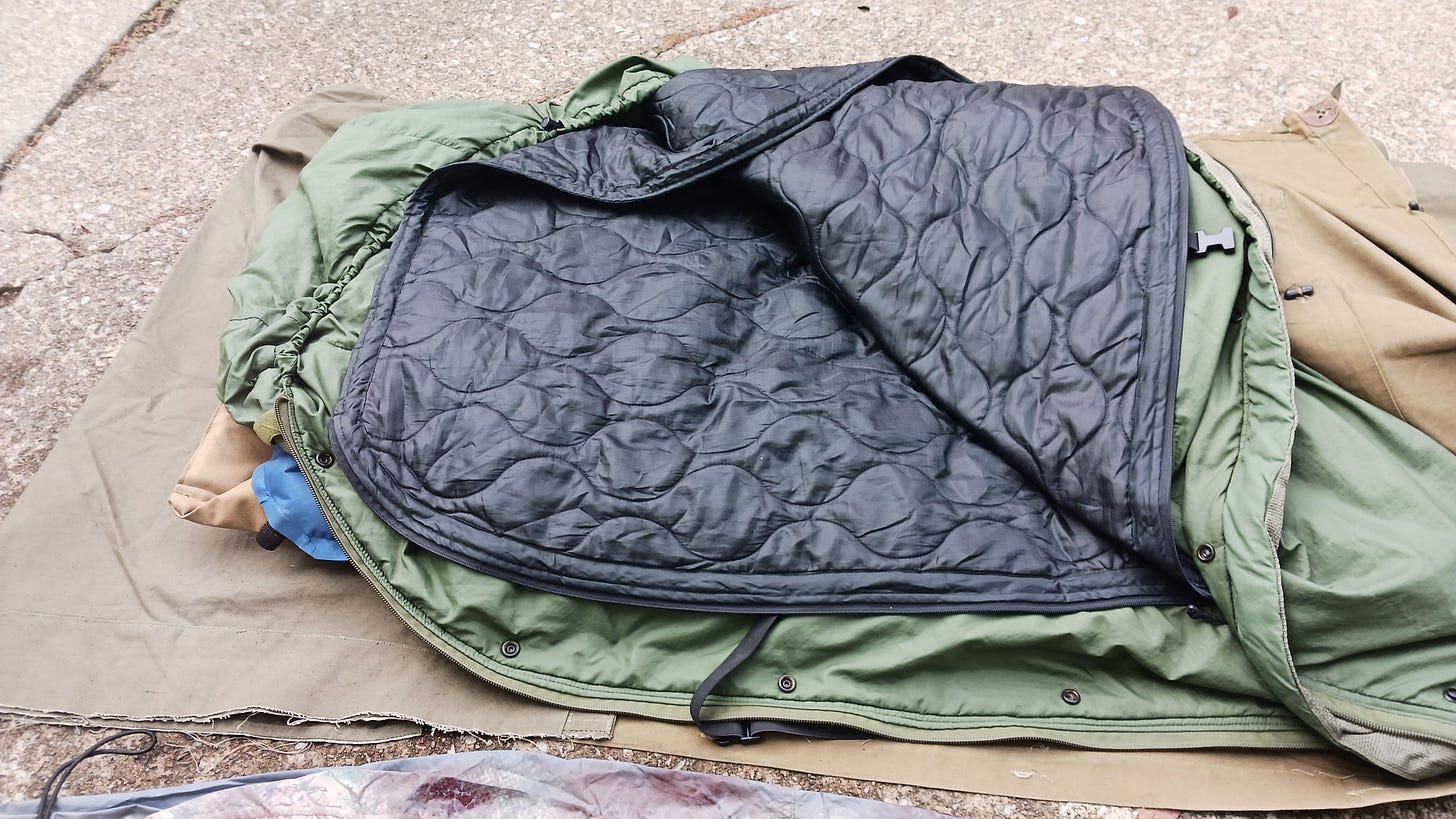
Bivy Sack-Mountain Hardwear Conduit SL Bivy
THE WINDSHIRT:
I was turned onto the idea of windshirts almost 3 decades ago! Incredibly lightweight, breathable, highly wind resistant, extremely packable, and still somewhat water resistant. Summer, winter, basecamp, on the move, it doesn’t matter they just plain work. Year round option that should be in everyone’s kit. Today there are numerous options in this category made from different nylons, polyesters, and cotton blends all with the goal of being highly wind resistant and breathable.
My first experience with windshirts was with mountaineering. It is hot, sweaty work (even in the wintertime) hauling heavy loads over varied terrain. Gore-Tex shells were never breathable enough and not having any kind of shell on and you would get chilled to the bone and never be able to warm back up. So a windshirt was the perfect solution to prevent heat convection loss and evaporative cooling. Both of these things happen when cold air or wind make contact with the sweat on your body and robbing you of your body heat. Windshirts enable you to maintain a more consistent body temperature while moving and resting in the field.
Sounds simple enough, right? The most important thing in cold weather conditions is to keep your skin dry. So moisture management (wicking and breathability) is huge here. The windshirt really excels at letting the moisture from your perspiration get pushed out through the fabric and, with keeping the wind off you, robbing you of precious body heat. Even at 10 or 20 degrees, a long underwear top and windshirt is sufficient at keeping you dry and comfortable while under movement. When you stop for a rest, pull that puffy out (we will discuss this layer more next month) and put it on over your windshirt and trap that body heat preventing you from cooling down too much, then when you’re ready to get underway again you peel off the puffy, stow it, and carry on your merry way!
There are a lot of options for windshirts out there with some of my favorites being the LL Bean Mountain Anorak, Helikon Tex Windrunner (super light and packable), or for a cost effective option, even an old school BDU field shirt (poly/cotton blend versions) will get the job done.
***Hints and tips that keep me dry & comfortable***
-I wear a stocking cap, wool socks, and long underwear inside my sleep system which enables me to be comfortable down to those temperatures. In rare cases it gets colder, I have added a Woobie Hoodie, used hot water bottles, or just plain sucked it up and suffered through it. It is important to get adequate field time for testing you and your kit, find out what will work for you and see what level of discomfort you are willing to endure.
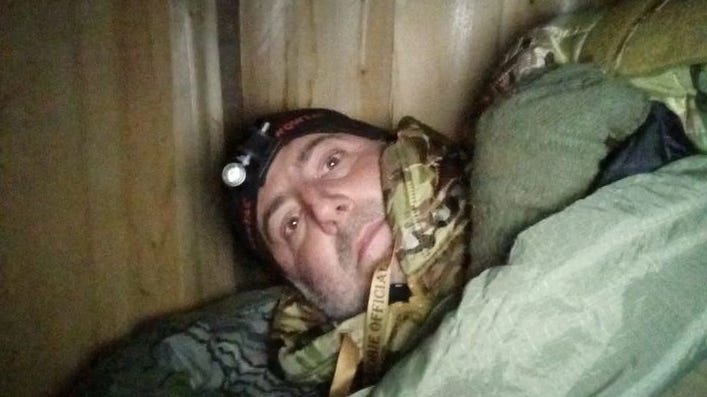
-If utilizing a “hot camp” meaning you are in an environment where having a fire is permissible, I will use the canvas Plash Palatka as my bivy set up like a cowboy roll. The canvas will protect your sleep system from sparks that will melt nylon/polyester bivy sacks.
-Do not sleep in the long underwear and socks you wore all day. Your sweat has permeated the material and they will work against you at night. I like to keep a “sleep set” of long underwear and socks just for sleeping. Now sometimes conditions just don’t allow the changing of so you roll with what you have on, but in ideal conditions this is a good habit to get into.
-Utilize those chemical hand warmers in your boots overnight so they don’t freeze, they won’t be nearly as hard to put back on in the morning. If your sleep system allows then sleep with them (or at least with your boot liners) if able.
-Get out and practice sleeping in cold weather. It takes practice to get comfortable with it. See how your body responds to it, what you can endure, and what you have to do to minimize the suck of it. I like the colder weather and if you know how to dress and stay dry the better off you will be.
Video from last year on cold weather layering systems! This differs a bit for most folks but the important thing is the tried and true philosophies behind laying and how it works.
Affiliate Highlight
Bear Creek Arsenal
Established in 2013, Bear Creek Arsenal has quickly become a leader in affordable AR-15, AR-10, our proprietary Rimfire ARs, PCCs, HuntMaster, and parts. With over 50 years of manufacturing and CNC experience, the founders of Bear Creek Arsenal® have always focused on producing high-quality, accurate, and reliable firearms for the everyday American. Manufacturing all key components in-house, in America allows Bear Creek Arsenal® to keep prices down while offering a huge variety of calibers and configurations for their customers.
The philosophy at Bear Creek Arsenal is that every American should afford to furnish their firearm collection with the highest quality of AR rifles, as their passion for owning premium firearms should not be overlooked by the cost to own one. The folks at Bear Creek Arsenal, are dedicated to that philosophy; providing their customers with the utmost quality – utilizing the finest machining methods and technology – to provide the most competitively priced AR rifles in the industry while exceeding their customers’ expectations.
"The AR platform is a staple mark of American freedom and liberties that we believe every American shooter should be able to afford to own."




